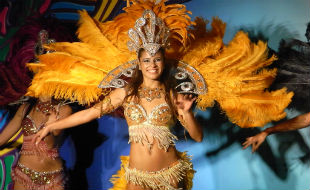
Ready to put on your dancing shoes and let your inner Latin dancer out? Then the Samba is the dance for you! One the the most popular dances in Brazil, the Samba has been performed by elaborately costumed “schools of Samba” at Carnival in Rio each year.
The name, Samba, is thought to come from the Kimbundu (Angolan) term “semba,” which is an invitation to dance and a name for the dance parties that former slaves held in Rio. Over time, the locals took what was then a public form of expression, and turned it into one of the most iconic forms of music and dance in Brazil.
The Samba is made up of two main movements, the forward basic movement and the back basic movement. To do each of these steps, you step forward (or backward) with one foot, tap the other to meet it and pulse your body up then down. The true character of the Samba is filled with flirtatious movements and a lot of motion in the hips.
Interestingly, most Americans didn’t even know the Samba existed until the early 1930s when Fred Astaire and Dolores Del Rio danced it in the film “Flying Down to Rio.” Thanks to our namesake, today it’s one of the most popular forms of ballroom dance across the United States.
Though as a form of ballroom dance, the Samba is still quite young, people in other countries have been dancing the Samba for hundreds of years. As you might expect, it has left a mark on many societies, and we bet if you tried it out, you’d see why! Come try out this intriguing, flirtatious dance and see if the playful Latin moves are up your alley.

